Justice, Equality and Taxation
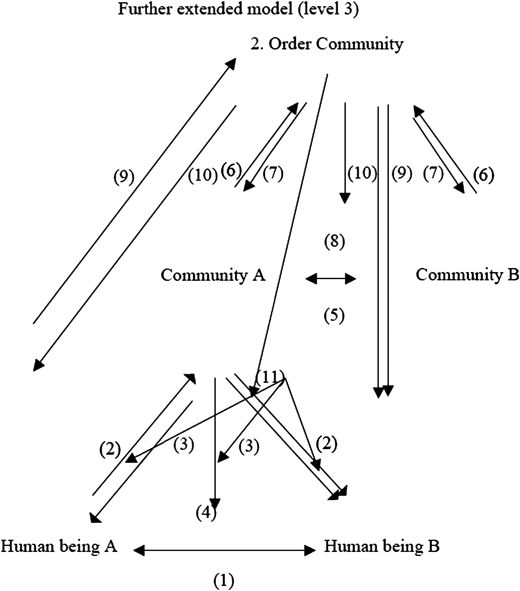
2. Beyond iustitia universalis, we can distinguish some more specific relations of justice: The two relations between A and B can be related via the ideal of equality, so via a second order relation.

We then get the more specific justice of exchange (1) = iustitia commutativa/inter-subjective justice. One example is when A buys a car from B, is the exchange just?
A more simple visualization is by a double-arrow:

The equity consideration is in this case limited to the pure worth/relation of equal exchange. E.g., it does not matter whether A or B are rich or poor.
3. More complex and decisive for our question concerning the justification of taxation are justice relations if one adds a third relatum/element. There are two fundamentally different possibilities. One could add (1) another individual C or (2) a community of individuals A and B. We will consider the first possibility initially, that is the addition of another individual C:
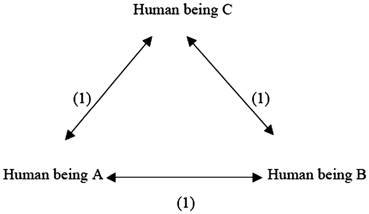
With the integration of a third relatum C we face an additional problem of interpersonal equality. Is C obliged to treat A and B equally?
The obligation of C to treat A and B equally depends on the status of their relationship. Imagine C is a private participant in an economic exchange. She buys her bread always from baker A and never from baker B. So she treats A and B unequally, but—according to our assumptions—she is not being unjust.
Imagine now C was the mother of A and B. She gives a piece of a cake only to A, but not to B. So she treats A and B unequally and her action is therefore unjust. What is the reason for this different evaluation? As a mother, C has the responsibility for her children, but not for specific bakers, because the family is a community with relations of mutual responsibility. Therefore, the obligation to treat others equally here depends on being responsible for them. In the economic market, the obligation to treat others equally is reduced or—under certain conditions—even abolished.
4. What changes occur when adding a community consisting of A and B? There are two main particularities emerging in this setting. First of all the treatment of A and B has to be principally equal because they are part of a community. The community is obliged to treat all members prima facie equally because they stand in a relation of mutual responsibility to each other.
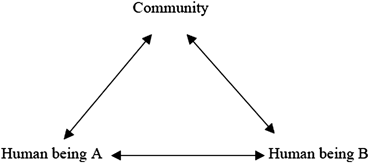
Secondly, the new type of relation between the community and the human being differs in one main respect from the basic type of relation between two human beings A and B since the relata are different. So non-symmetry arises in these relations even at a structural level. Therefore, we could split the communal relation into two different types of relations: a relation of contribution from a human being to the community (2) and a relation of distribution from the community to a human being (3).
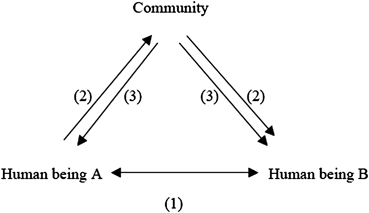
We can identify the relation (2) of the single members to the community. This relation can also be found in Plato. (Plato 1990c, p. 161b5 ff., 1990d p. 370a4, 433a1 ff., 1990e I 127a14 ff.; Aristotle 1984, V 2, p. 1129a33 f.). It was named “iustitia legalis” in the middle ages (Thomas Aquinas 1987, II-II, qu. 58, 6, 9 ad tertium; Thomas Aquinas 1993, p. 293 ff.). More appropriate would be “iustitia contributiva”, or “contributive justice” instead, because not only is obedience towards laws (legal justice) a matter of this relation but also the deliverance of contributions (contributive justice) and acts of legitimisation of the community. The relation of contributive justice is the kernel of our main question, which taxation is just. E.g. are inequalities of income, wealth or consumption decisive? Which form of measurement is justified? A head tax? A proportional tax? A progressive tax?
However, we cannot limit our considerations to this contributional relation because the contribution is only one aspect of the more encompassing view of justice.
The relation (3) of the community to the single member is also mentioned by Plato, (Plato 1990d, p. 433e12 f.), but was first carefully developed by Aristotle (Aristotle 1984, V 5, p. 1130b33 ff.). It was named traditionally “iustitia distributiva” (Thomas Aquinas 1987, II-II, qu. 61, p. 1 ff.; Thomas Aquinas 1993, p. 284 ff.). It comprises the main question about the distribution of tax revenues in order to sustain political projects and redistribute goods.
5. The distinction between the relations of contributive and distributive justice opens up the space for three different meta-questions of equality.
(1) One can ask intrapersonally: do a person’s contributions and her gain from distribution stand in a justified relation? Example, do the taxes and individual gains show an equality relation, e.g. the pensions in a public pension-system and the contributions to this pension-system?
(2) One can ask, for two or more human beings involved, e. g. A and B, but restricted to one type of justice relation (contribution or distribution), that is interpersonally isolating, are the isolated contributions and distributions of different individuals just? This question has two parts: (a) Do A and B contribute justly, in a manner that is prima facie equal? (b) Do A and B get a just share of the distribution that is prima facie equal?
(3) One can finally ask, for two or more human beings involved and for all justice relations (contribution and distribution) that are interpersonally non-isolating, are the joined contributions and distributions of several individuals just, in a manner that is prima facie equal?
6. In one special case, a unification of two of the later relations deserves special structural consideration, if the community directs one action to two members with respect to their basic relation (1). We then get a fourth fundamental type of justice-relation within a community:
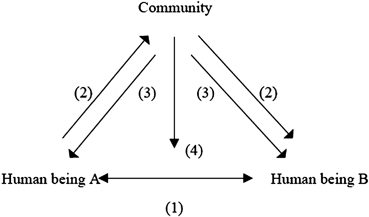
This relation (4) could be named corrective or commutative justice (iustitia correctiva vel commutativa). The wider name “iustitia correctiva”, “corrective justice”, is preferable because an exchange does not always take place. This relation comprises the correction of every form of unjust interactions, e.g. in civil law and penal law. It also comprises the correction of historical injustice by the individual members, e.g. through slavery or suppression by private persons or communities. It is not limited to the correction of intended or negligent wrongdoing. It is also not limited to the correction of actions by identifiable members of the community. However, in these cases the distinctions between corrective justice and distributive as well as contributive justice become blurred. In some cases, taxes do not only aim at collecting revenues but also at correcting or limiting private interactions, e.g. the excessive consumption of alcohol, tobacco or fuels.
4.3 Material Principles of Justice
All four types of relations need some material principle as a complement. However, and importantly, not all relations need the same principle as a complement!
In the literature one finds a lot of material relating to principles of justice: the principle of equality, the maximizing principle of Utilitarianism, the Pareto principle, the difference/maximin principle of Rawls etc. (Rawls 1973; see von der Pfordten 2010, p. 168 ff.). Usually the problem is this, many theories of social justice mainly pay attention to distributional relations, e. g. within Rawls, thereby narrowing the concept of justice. The justice of exchange, of contribution and of correction are seldom covered or at least not covered extensively. It is clear that this is not acceptable. Moreover, it is certainly not justified in a theory of taxation, where contributional justice is at stake.
2. Robert Nozick formulated a fundamental critique of taxation in Anarchy, State and Utopia (Nozick 1974, 161 ff.). He used the basketball-star Wilt Chamberlain as an example and asked, rhetorically, why should the state be allowed to tax the extra 25 cents everybody pays to see Wilt Chamberlain play? Nozick assumes that everybody who pays the 25 cents originally owns the money paid and that the transfer to Wilt Chamberlain is just. Therefore, he can see no justification in taxing Chamberlain’s income.
However, this is not convincing. The taxation of Chamberlain’s income is justified because the community provides some conditions that are necessary for attaining this income: public roads, stadiums, police forces, a law-system, education, etc. Without all these partly publicly financed goods it would be impossible for Wilt Chamberlain to become a basketball-star and earn the money. However, we have to formulate this concept of justice more carefully.
3. A first step is to realize that in most cases the distribution (of money obtained from taxes) by the state is factually impossible without any contributions (from taxpayers). Today, the main source of revenue is taxation. Therefore, there is a factual link between distribution and contribution. This factual link leads to a first partial and negative justification of taxation. If the political project, which is financed by taxation, is in a fundamental way unjustified, then the taxation to finance this project cannot be justified. Therefore, a criminal regime cannot claim that its taxation is justified. Everybody can ethically refuse to pay taxes to sustain this regime. This rationale was invoked when Henry David Thoreau refused to pay taxes as long as the practice of slavery was not abolished by the American state (Thoreau 1993, pp. 1–18).
However, the positive relation does not hold. The justification for the distribution is not sufficient to justify the contribution and one needs additional reasons instead.
The next step is to ask which material principle can possibly justify taxation. For an answer, I will refer to other work (von der Pfordten 2010, p. 23 ff., 2012, pp. 449–471.). Fundamental for any ethics is the principle of normative individualism/humanism which states that only individuals can be the ultimate point of reference for moral obligations and hence the justificatory source of ethics, politics and law. Collective entities such as nations, peoples, societies, communities, clans, families, communicative groups or eco-systems, etc. cannot fulfil this function. 3
After accepting normative individualism, one has to ask what the decisive normative qualities of the individuals are. Here we see a continuum between purely corporal strivings, corporally based needs, mostly mental needs and purely mental aims. These four normative qualities can be summarized under the label of concerns/interests.
This leads to a first conclusion with respect to the factual link between contributions and distributions and the first partial justification founded upon this link. Projects of the political community are partially justified if and only if there is (1) some sort of assumed general constitutional agreement of all members to finance common projects/distributions and (2) a majority agreement (or their representatives agree) on the specific projects which are undertaken.
4. Beyond this, what can the main principle to reach a just system of contributions be? A solution is offered by the following “principle of the relative dependence of individual concerns on others”, which has been explained and defended on another occasion (See: von der Pfordten 2010, p. 210 ff., 2012, pp. 449–471):
The more the origins or the realization of the concerns or the interests of a morally considerable individual depend on others or a community, the more the respective concerns and interests have to be relativized in the process of deliberation, and the more the community may decide according to its common goals.
What does it mean to say that the origins or the realization of one’s concerns depend on others or a community? There may be two reasons for such a dependency: (1) historically and retrospectively, a certain shared practice serves as a necessary condition for the development of a certain concern, e.g., the emergence of a certain sport such as jogging as a condition for the desire to go jogging; (2) instrumentally and prospectively, a certain practice can only be realized with others or within a particular community with its particular institutions, e.g., the interest to communicate with others or to make use of certain infrastructural facilities.
Ideally, the relative dependence of individual concerns on others takes the form of a continuum. At the one end, there are concerns that depend on others only to a minor degree or not at all. At best, they may be supported by others, such as life, physical integrity, thinking, etc. These interests can be realised all over the world, in all cultures and societies. For them, in particular, the principle of equality holds. The interest not to be tortured, for instance, combines the interest in one’s own physical integrity and the interest in self-determination—both of which are not dependent on any community, thus increasing their strong dependency on the individual. For that reason, the interest not to be tortured must remain unaffected by relativising deliberations as much as possible (Cf. von der Pfordten 2006, pp. 149–172).
At the other end of the continuum, there are concerns which are almost totally dependent upon others or the social community, such as, e. g., an interest in communicating with others, working together with others, visiting public institutions, such as museums and in making use of the public transport system, and one’s interest in social aid, a common economy, in natural resources, such as oil or coal, and in sustaining the community. For these concerns—all strongly dependent on a community—the maximizing principle notably holds because each concern’s dependency on the community justifies the common decision. Single individuals have, in these cases, no legitimization to veto the aim of collective maximization. In between the two extremes there is, e.g., an interest in being treated with respect, in being informed about facts of personal relevance, interests in employment, freedom of speech and the use of one’s own goods, etc. In these cases, it is much more difficult to choose a single principle. Several factors are decisive for the choice, like the relative dependence of the interests of the individuals in respect to the community and the importance for the bearer of that particular principle, but also the content of the interests. Many principles are candidates for such application. Moreover, even a combination of principles is possible. What might be a justification of the principle of the relative dependence of individual concerns on others?